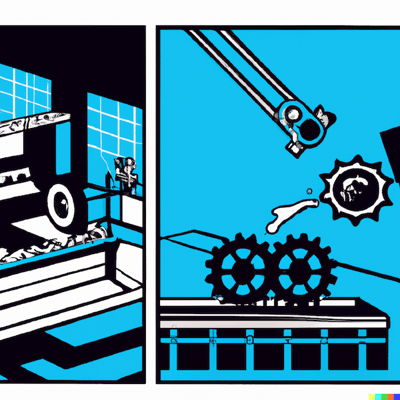Tl;dr - Machinery sales teams often operate in an unaccountable manner that contrasts sharply with their colleagues who build the capital equipment they sell. It's time to change that; figuratively and literally. Data from sales force testing provide the factual root cause insights on which kaizen-type initiatives can be built to improve sales force effectiveness rather than fruitlessly chasing symptoms.
The Andon Cord - Physical Action and a Philosophical Commitment to Getting it Right
As Japanese manufacturers began to re-engineer manufacturing, they implemented various tools and techniques including the Andon Cord. The Andon Cord is a rope that, when pulled by anyone on the assembly line, instantly stops the line1. Stopping the line follows the Toyota concept called "Jidoka. The idea behind Jidoka is that by stopping the system, you get an immediate opportunity for improvement, or find a root cause, as opposed to letting the defect move further down the line and be unresolved."2
This was a radical departure from earlier approaches when folks on the line would just shrug and ignore problems, resigned that it wasn't their job. Some might noted an observation for discussion at future staff meetings, but workers weren't empowered, solutions weren't immediate, and chronically low-quality production and ossified indifference were the consequences.
The willingness to abruptly stop the process creates the impetus and space for root cause analysis. To start again, people had to figure out what was wrong. And with the pressure of halted production, resources and attention were committed to that outcome.
Today, as a result, root cause analysis is 2nd nature for many business people in most business disciplines.
There's a glaring exception. Industrial sales.
Most capital equipment sales teams completely ignore this critical best practice that empowers their colleagues on the other side of the proverbial business wall.
Analogies to Machinery Sales
When problems arise on the production line, they first become apparent as symptoms.
It could be that something doesn't "look right" or doesn't quite fit. Or maybe fixtures have worn, or lighting has dimmed. None of those define the problem, which could be suppliers, materials, another worker, dirty power, wet compressed air, or countless other factors. The point is that someone recognizes something that isn't quite right, and that's adequate impetus to drill down, and down, and down to figure it out at the root cause level.
Sometimes it's resolved immediately. In other cases, there's research to do, and a formal kaizen event is planned with a multidisciplinary team. But they identify and resolve the root cause.
Contrast that with most machinery sales teams which show common, aggravating symptoms.
- discounting
- reflexive and excessive quoting
- deals ending in no decision
- lack of clarity into a prospect's budget, decision maker, decision criteria, or timeline
- competitive surprises & losses
- most sales come from existing customer repeat orders - very few new logos
- difficulty getting meetings with new prospects
- inability to displace incumbent competitors
- long sales cycles
- inaccurate forecasts
- costly sales rep turnover
- low inbound lead conversion rates
- no progress on target accounts
You can certainly list more.
Now think about how the sales team reacts when a symptom is noticed.
For instance, when the projected close date for a project comes and goes with no order, who pulls the cord to light the lamp, shut down the line, and get to the bottom of what's happening?
Nobody.
There's a completely different mindset around manufacturing marketing and machinery sales than we have around production and operations.
Sales may feel overwhelming, intimidating, or a black box. It may seem that manufacturing is facts and millimeters while sales is personalities and unknowns. That's fallacious.
An effective sales process, rigorous training and coaching, proper sales technology, accountability and consistent use of CRM and the full sales tech stack, and sales force testing can collectively achieve the same degree of granular process insight we expect in production.
Using Sales Force Testing to Identify and Correct Root Causes of Machinery Sales Problems

|
| ai generated image by Dall E (prompt = "a lithograph of a modern manufacturing line suddenly stopped to fix a quality issue" |
Here's where it gets interesting. Capital equipment manufacturers are DiY can-do types. They have two strong attributes that tend to get in the way of fixing marketing and sales problems.
- They build stuff. They do it well. They assume they can do so ubiquitously across their product and their operation.
- They use data to understand problems and solutions, except in sales and marketing.
So when they finally reach a point where frustration peaks and they are triggered to solve a sales problem, they diagnose themselves and try to build their own solution.
That often sounds like, "We have a problem. Our reps discount too often to get deals. They need to get better at negotiation. So we need some training in negotiation." And just like that, someone's deputized to put together a one-hour Chris Voss tips and techniques session at the next sales meeting.
Chris Voss is great, but there are clear problems with this approach.
First, assuming that weak negotiation skills were in fact the root cause, building negotiation muscles that can be effectively flexed takes time, repetitions, coaching, and role-playing. A one-time in-house session doesn't do it.
Second, negotiation is a commonly diagnosed weakness, but it's rarely a root cause. Deals devolve into pricing quibbles because of numerous sales mistakes throughout the entire sales process. When a deal is properly sold (with the decision maker, understanding compelling reasons to buy, creating urgency, etc.) typically there is no pricing discussion at the 11th hour. At most, there's a reflexive discount demand from procurement which is a bluff because competition has been removed along the way.
We know from our manufacturing root cause analysis that there's something deeper at play. We need to figure out the root cause.
I get it. That can feel like a daunting task, like troubleshooting an intermittent electrical issue. The symptom may surface in varying degrees on different deals and with different reps.
That's where sales force testing comes into play. The proper sales team evaluation will peel back countless layers of your sales onion and quickly identify:
- team strengths and weaknesses
- individual attributes, mindsets, and competencies
Frequent discounting result from poor negotiation skills; it's often because
- teams don't have the right sales process and accountability
- sales managers don't coach enough, on the right topics, or conduct effective pipeline reviews
- reps are afraid to talk about money, hesitate to ask important questions to avoid offending a prospect, never identify the decision maker, can't sell value, don't ask effective questions and therefore don't sell consultative, present prematurely, establish trust, etc
An effective sales team evaluation and analysis will accurately identify each underlying issue, individually and in aggregate. This includes issues that reps and managers will vigorously protest - proof positive that you're getting close to the issue!
This insight - line of sight to the root cause of sales dysfunction and unpredictability - is a hugely valuable shortcut to fixing the problems.
Sales Force Effectiveness Kaizen
Knowing the root cause doesn't mean it's easy to fix. If incoming component quality is a root cause issue in your manufacturing, that may trigger a lengthy process of training a supplier on quality process, sourcing alternatives, and/or redesigning the challenging components. You'll probably run a kaizen to develop the best solution.
The problem won't be fixed overnight. You'll struggle to manage the symptom in the meantime. But you'll be on track to truly eliminating the problem, which will in turn, resolve the symptom.
Why don't we do the same with sales? Why not take aggregate and atomic insights from effective sales force testing, assemble a kaizen team, and create an improvement plan to boost sales force effectiveness?
The answer is twofold. First, companies aren't aware that this sort of amazing insight is available. They may be familiar with diagnostic personality and behavioral tools like DiSC® Profile and realize that those tools aren't able to explore critical sales mindset and competency issues. They don't realize they can get the data they need.
Second, they might be afraid of change. It's hard work. There are egos, org chart clout, and budget allocations at stake. Accountability is tiring. Sales training requires uncomfortable change.
But they know from the manufacturing side of the business that ignoring the problem doesn't make it better. A bandaid (just like another QC step for problematic incoming components) can reduce the symptom but not address the root cause. In sales this means they'll see the same bogus forecast every month and just hope they close the deals they need.
We must take the same approach to sales (and marketing too) that we've learned is necessary to improve manufacturing. Revenue growth is a system. A process to be engineered and continuously improved.
STOP the Line When You Must
Accurate sales force testing represents a tipping point.
Without it, you have no choice but to grit your teeth, couch every forecast in lots of caveats, suffer through countless sales meetings seeing deals shuffled to the next quarter, and tolerate 70% of reps routinely missing quota.
 With effective sales team evaluations, you can identify root cause issues and fix them - through training, coaching, process engineering, and in some cases, adding top talent and even replacing non-performers (whose lack of performance you suddenly can explain empirically.)
With effective sales team evaluations, you can identify root cause issues and fix them - through training, coaching, process engineering, and in some cases, adding top talent and even replacing non-performers (whose lack of performance you suddenly can explain empirically.)
And you need a mindset change.
You might also need a physical manifestation to make the change concrete for everyone.
Just as many sales teams have a bell they ring when they wing a big order, maybe it's time to have a physical andon cord in your sales conference room connected to a lamp that's used to alert the whole team that you've discovered concerning sales symptoms, are working on root cause analysis, and will implement an improvement plan.
Make it real.
Make it accountable.


